 W
WAcrocera orbicula, also known as the top-horned hunchback, is a species of fly belonging to the family Acroceridae. The species has a holarctic distribution, ranging from North America to the Palaearctic.
 W
WAnasimyia lineata is a Palaearctic species of hoverfly.
 W
WAntaxius pedestris is a species of "katydids crickets" belonging to the family Tettigoniidae. It was originally described by Johan Christian Fabricius under the scientific name of Locusta pedestris.
 W
WThe dwarf honey bee, Apis florea, is one of two species of small, wild honey bees of southern and southeastern Asia. It has a much wider distribution than its sister species, Apis andreniformis. First identified in the late 18th century, Apis florea is unique for its morphology, foraging behavior and defensive mechanisms like making a piping noise. Apis florea have open nests and small colonies, which makes them more susceptible to predation than cavity nesters with large numbers of defensive workers. These honey bees are important pollinators and therefore commodified in countries like Cambodia.
 W
WBombus morio is one of the few bumblebee species found in South America. These bees reside mainly in the forests of Brazil, nesting on the surface of the ground. They are one of the biggest species of bumblebee and are important pollinators. They are one of the few species of bees that exhibit buzz pollination to collect pollen from the flowers.
 W
WCalliphora quadrimaculata, commonly known as the New Zealand blue blowfly and by its Maori name rango pango, is an insect in the genus Calliphora of family Calliphoridae in the order Diptera. This particular blowfly is found throughout New Zealand as well as on Chatham, Auckland, Stewart and Campbell Islands that surround New Zealand. Generally blowfly maggots in New Zealand have to feed on animal tissue or faeces to develop into adult blowflies. However the New Zealand blue blowfly larvae can survive on decaying leaves of snow tussock in alpine regions and reach adult maturity without feeding on any animal tissue.
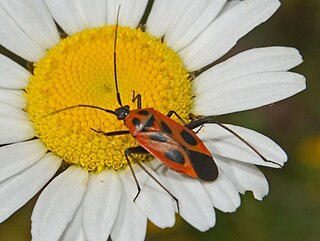 W
WCalocoris nemoralis is a species of true bugs belonging to the family Miridae or jumping tree bugs, subfamily Mirinae.
 W
WCamponotus compressus is a type of ground-nesting species of ant found in India and Southeast Asia. It is a frequent visitor to toilets as it consumes urea. It is one of the many species which tends plant-sap-sucking insects like aphids and tree hoppers. They add nutrients into the soil through their discarded waste piles These ants stroke their antenna on the hind parts of these insects stimulating them to excrete a sugar rich liquid, called honeydew, which the ants consume. In return, they are known to protect the insects from predators like ladybugs.
 W
WCeratina smaragdula, also known as Ceratina (Pithitis) smaragdula, is a species of green metallic bees belonging to the family Apidae, subfamily Xylocopinae.
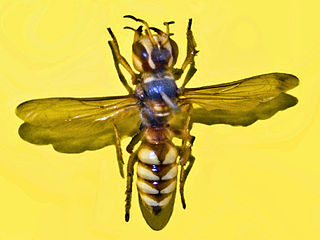 W
WCerceris tuberculata is a species of wasp in the family Crabronidae.
 W
WCodophila varia is a species of shield bug belonging to the subfamily Pentatominae in the family Pentatomidae.
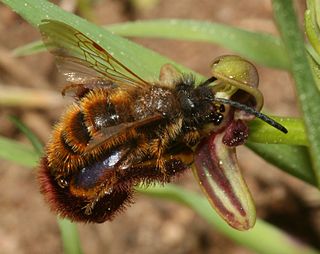 W
WDasyscolia ciliata is a species of scoliid wasp found throughout the Mediterranean.
 W
WDendroleon pantherinus is a species of neuropteran insects of the antlions (Myrmeleontidae) family.
 W
WDictyophorus spumans, the koppie foam grasshopper or rooibaadjie, is a species of grasshopper in the family Pyrgomorphidae indigenous to Africa. The name "foaming grasshopper" derives from the insect's ability to produce a toxic foam from its thoracic glands. It is closely related to Phymateus.
 W
WDioctria linearis is a Palearctic species of robber fly in the family Asilidae.
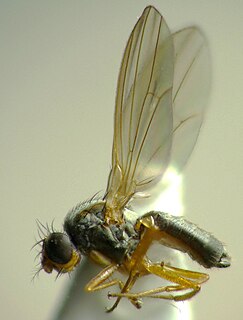 W
WDrosophila funebris is a species of fruit fly. It was originally described by Johan Christian Fabricius in 1787, and placed in the genus Musca but is now the type species of the paraphyletic genus Drosophila. Drosophila funebris is a member of the Immigrans-tripunctata radiation of the subgenus Drosophila.
 W
WEmpis ciliata, the black dance fly, is a species of dance fly, in the fly family Empididae.
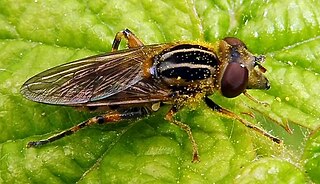 W
WLejops lineatus is a species of syrphid fly in the family Syrphidae.
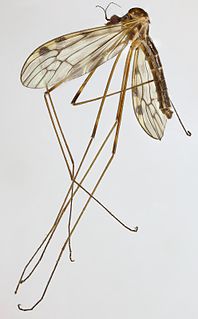 W
WLimonia flavipes is a species of fly in the family Limoniidae. It is found in the Palearctic.
 W
WLoensia fasciata is a species of Psocoptera from Liposcelididae family that can be found in Great Britain and Ireland. The species are yellowish-black.
 W
WMegachile rotundata, the alfalfa leafcutting bee, is a European bee that has been introduced to various regions around the world. As a solitary bee species, it does not build colonies or store honey, but is a very efficient pollinator of alfalfa, carrots, other vegetables and some fruits. Because of this, farmers often use M. rotundata as a pollination aid by distributing M. rotundata prepupae around their crops. Each female will construct and provision her own nest, which is built in old trees or log tunnels. Being a leafcutter bee, these nests are lined with cut leaves. These bees feed on pollen and nectar and display sexual dimorphism. This species has been known to bite and sting, however it poses no overall danger unless it is threatened or harmed and its sting has been described as half as painful as a honey bee's.
 W
WOmalus aeneus is a species of cuckoo wasps belonging to the family Chrysididae.
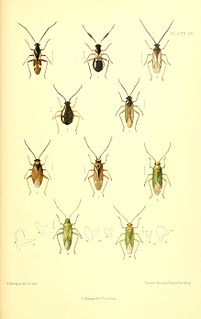 W
WOrthotylus nassatus is a species of bug from a family of Miridae that can be found everywhere in Europe except for Andorra, Liechtenstein, and various European islands. and east across the Palearctic to Siberia and from Asia Minor to the Caucasus.
 W
WPalpada agrorum is a species of syrphid fly in the family Syrphidae.
 W
WPalpopleura sexmaculata, commonly known as the Asian widow or blue-tailed yellow skimmer, is a species of dragonfly in the family Libellulidae. It is widespread in several countries in South, East and Southeast Asia, but is no longer believed to occur in Sri Lanka.
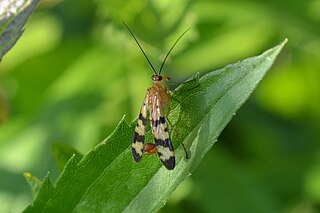 W
WPanorpa americana is a species of common scorpionfly in the family Panorpidae. It is found in North America.
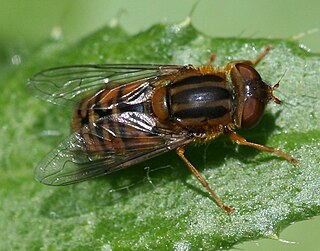 W
WParhelophilus versicolor is a European hoverfly.
 W
WPhaonia pallida, the muscid fly or orange muscid fly, is a species of fly in the family Muscidae.
 W
WPlatycheirus rosarum is a species of hoverfly found in the Palearctic. Like its close relative Platycheirus granditarsus, it can be found in marshy meadows and ditches; indeed, the two species can often be found together. The flight time is between May and October, though it peaks in abundance in June and July.
 W
WPrionocera turcica is a species of fly in the family Tipulidae. It is found in the Palearctic.
 W
WPtychoptera albimana is a species of fly in the family Ptychopteridae. It can be found throughout the Palearctic but commonly found throughout Britain.
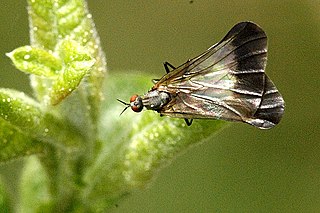 W
WRhamphomyia marginata is a species of dance flies, in the fly family Empididae. It is found in Europe, from Great Britain east to Romania and from Fennoscandia south to France, Austria and Hungary.
 W
WStenodema holsata is a species of bug from the family Miridae.
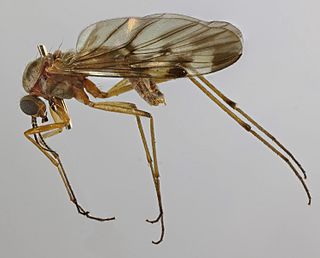 W
WSylvicola cinctus is a species of fly in the family Anisopodidae. It is found in the Palearctic.
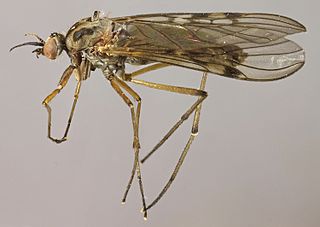 W
WSylvicola punctatus is a species of fly in the family Anisopodidae. It is found in the Palearctic.
 W
WTherioplectes gigas is horse fly in the family Tabanidae. The species was first described by Johann Friedrich Wilhelm Herbst in 1787.
 W
WTosena fasciata is a cicada species from Southeast Asia that has been recorded from Sumatra, Java, Borneo and Ambon Island
 W
WTremex fuscicornis is a species of horntail, native to Europe and Asia, and has been introduced to Australia, Canada and Chile.
 W
WTrogus lapidator is a species of ichneumon wasp in the family Ichneumonidae.
 W
WVespa bicolor, the black shield wasp, described by Johan Christian Fabricius in 1787, is a species of hornet which has been found to be the pollinator of an orchid, Dendrobium sinense, found only on the Chinese island of Hainan. Vespa bicolor also preys on honey bees, which it feeds to its larvae. The orchid produces a chemical that mimics a honey bee pheromone and attracts this predatory wasp.